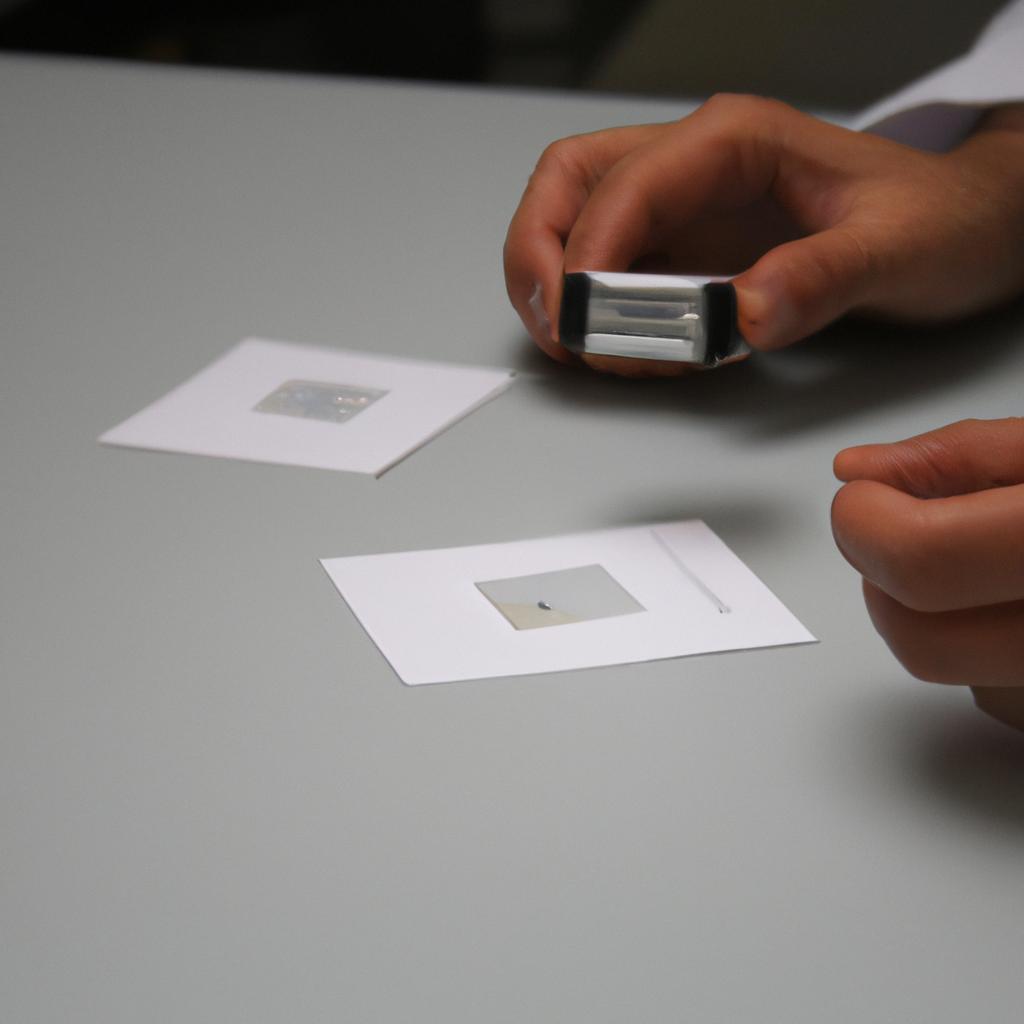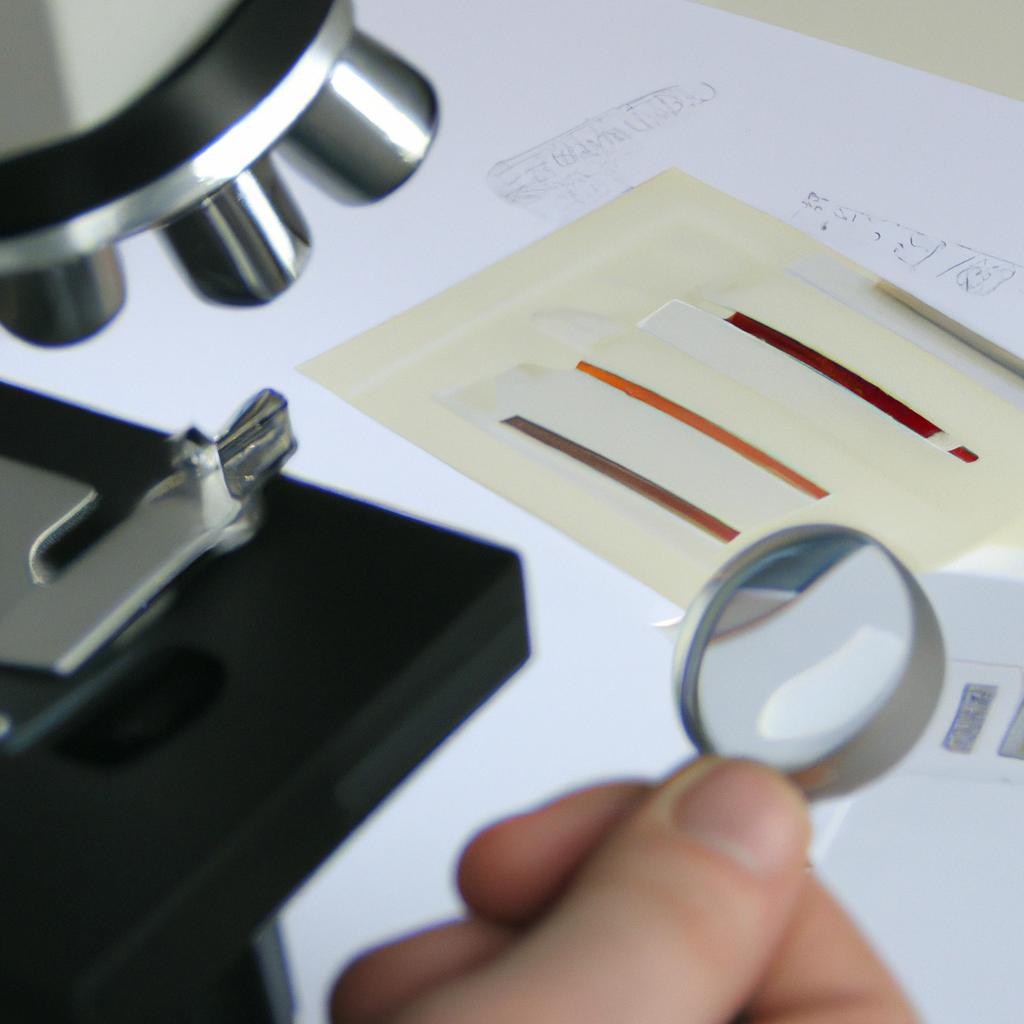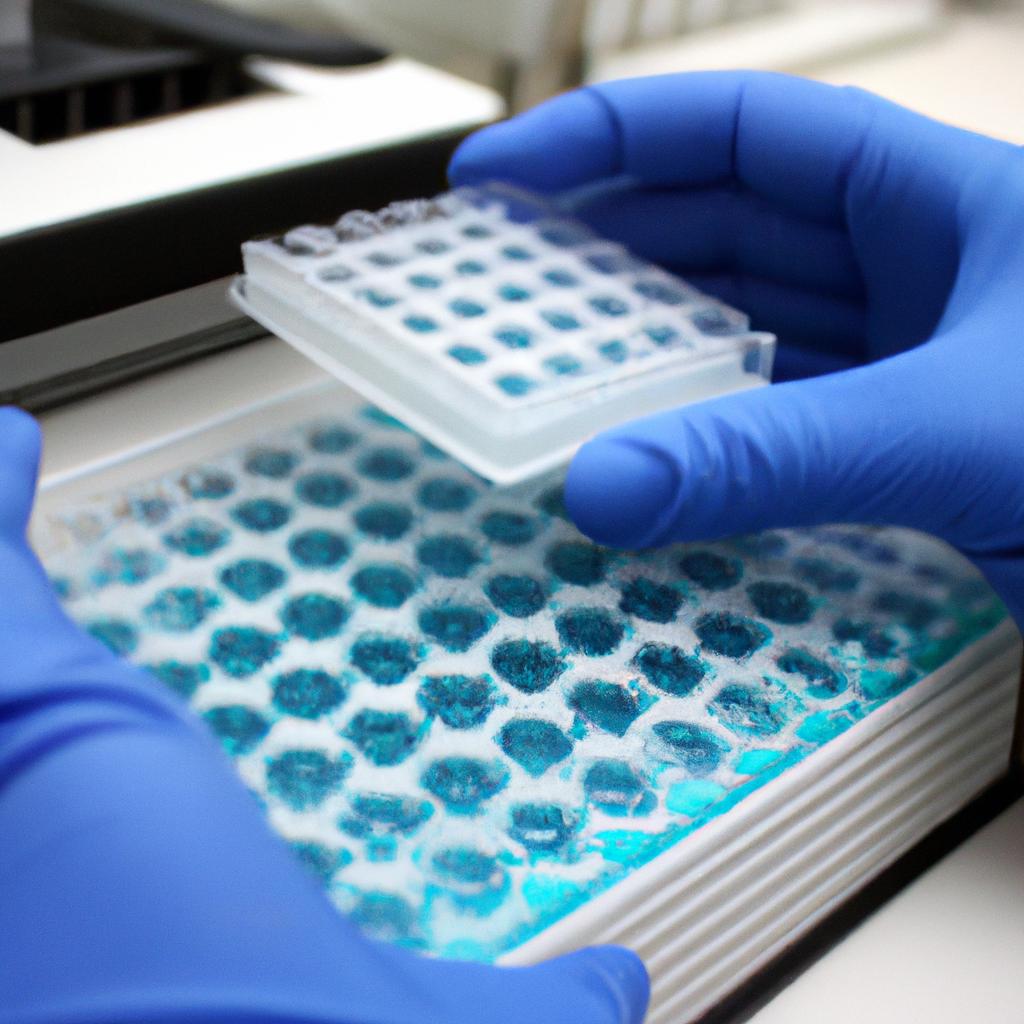Nuclear abnormalities in veterinary clinical pathology play a crucial role in the diagnosis and management of various diseases. The study of cellular morphology enables veterinarians to identify deviations from normal nuclear features, leading to an accurate assessment of pathological conditions. For instance, consider a hypothetical case where a canine patient presents with lethargy, weight loss, and abnormal bleeding. By examining the nuclear characteristics of blood cells under a microscope, veterinary professionals can detect potential cancerous or infectious processes that may be underlying these symptoms.
Understanding cellular morphology and its relationship to nuclear abnormalities is essential for both diagnostic purposes and monitoring treatment response. In veterinary medicine, practitioners rely on observations made through microscopic examination of tissue samples or body fluids to assess the health status of animals. Changes in nuclear shape, size, chromatin pattern, and presence of inclusion bodies provide valuable insights into disease progression and prognosis. Consequently, knowledge about cellular morphological alterations associated with specific pathologies equips veterinarians with the necessary tools to make informed decisions regarding further diagnostics and appropriate therapeutic interventions.
In this article, we will explore different types of nuclear abnormalities encountered in veterinary clinical pathology while emphasizing their significance in diagnosing various diseases. We will discuss key aspects related to cellular morphology such as changes observed in neoplastic conditions, infectious agents , inflammatory processes, and hematological disorders. By understanding the nuclear abnormalities associated with these conditions, veterinarians can accurately diagnose and manage diseases in their patients.
Neoplastic conditions often exhibit distinct nuclear abnormalities that can aid in diagnosis. For example, cancerous cells may display enlarged nuclei with irregular contours and increased chromatin density. The presence of pleomorphism, anisokaryosis (variation in nuclear size), and hyperchromasia (increased staining intensity) can also indicate malignancy. Additionally, the identification of mitotic figures or abnormal mitoses within the nucleus is suggestive of a rapidly dividing tumor.
Infectious agents can cause specific changes in cellular morphology as well. Viral infections may result in characteristic inclusion bodies within the nucleus, such as Cowdry type A or B bodies seen in herpesvirus infections. Bacterial infections can lead to neutrophilic inflammation characterized by segmented neutrophils displaying toxic changes, including hyposegmentation or Döhle bodies in their nuclei.
Inflammatory processes can also induce nuclear abnormalities that help identify underlying diseases. In conditions like autoimmune hemolytic anemia or immune-mediated thrombocytopenia, immune cells may exhibit features such as nuclear hypersegmentation or cytoplasmic vacuolation due to phagocytic activity.
Hematological disorders often present with notable nuclear abnormalities as well. In cases of certain leukemias or lymphomas, abnormal lymphocytes with large nuclei and dispersed chromatin patterns called “smudge cells” may be observed. Other hematological conditions like iron deficiency anemia can lead to small-sized red blood cells with hypochromic nuclei.
Overall, understanding nuclear abnormalities allows veterinary professionals to make accurate diagnoses and develop appropriate treatment plans for their patients. By examining cellular morphology and recognizing deviations from normal nuclear features, veterinarians can provide optimal care for animals affected by various diseases.
Overview of nuclear abnormalities in veterinary clinical pathology
The study of nuclear abnormalities in veterinary clinical pathology is a crucial aspect of diagnosing and monitoring diseases in animals. By examining the cellular morphology, pathologists can identify various deviations from normal nuclear characteristics that provide invaluable insights into the underlying conditions affecting an animal’s health.
To illustrate the importance of this field, consider a hypothetical case involving a domestic cat presenting with unexplained weight loss and lethargy. A blood sample analysis reveals numerous abnormal nuclei within the leukocytes, indicating potential pathological changes occurring within the cat’s immune system. This example demonstrates how detecting nuclear abnormalities can serve as a starting point for further investigations to determine the specific disease or condition afflicting an animal.
Understanding the significance of these abnormalities requires careful observation and interpretation by experienced professionals. To aid in this process, we present four key factors highlighting both the emotional impact and diagnostic value associated with identifying nuclear abnormalities:
- Early detection: The presence of certain types of nuclear abnormalities may precede other clinical signs, allowing for early intervention and potentially increasing treatment success rates.
- Disease progression assessment: Monitoring changes in nuclear morphology over time can provide valuable information about disease progression, response to therapy, and prognosis.
- Identification of malignancies: Nuclear alterations often play a significant role in distinguishing benign conditions from malignant neoplasms.
- Forensic implications: In cases where abuse or neglect is suspected, evaluating nuclear anomalies can contribute to forensic evidence gathering and assist legal proceedings.
In addition to bullet points emphasizing these aspects, it is also helpful to incorporate visual aids such as tables. Below is an illustrative three-column table showcasing common examples of nuclear abnormalities observed in veterinary patients:
| Abnormality | Description | Associated Conditions |
|---|---|---|
| Karyomegaly | Enlarged nucleus | Hepatic disease |
| Anisokaryosis | Unequal nuclear size | Neoplasia |
| Pyknosis | Shrunken and condensed nucleus | Cell death or degeneration |
| Hypersegmented | Excessive lobes in the nucleus of neutrophils | Nutritional deficiencies (e.g., vitamin B12 deficiency) |
In conclusion, the study of nuclear abnormalities in veterinary clinical pathology offers valuable insights into an animal’s health status. By detecting these deviations from normal cellular morphology, veterinarians can make informed diagnoses, monitor disease progression, assess treatment effectiveness, and even contribute to forensic investigations. In the following section, we will delve further into the causes and significance of nuclear abnormalities in veterinary patients.
Causes and significance of nuclear abnormalities in veterinary patients
Nuclear abnormalities in veterinary clinical pathology can provide valuable insights into the health and disease status of animals. By examining cellular morphology, veterinarians are able to identify various nuclear changes that may indicate underlying conditions or disorders. One example is the presence of multinucleated cells, which can occur due to viral infections such as canine distemper virus.
Understanding the causes and significance of these nuclear abnormalities is crucial for accurate diagnosis and appropriate treatment planning. There are several factors that contribute to the development of nuclear abnormalities in veterinary patients:
- Genetic mutations: Inherited genetic defects can lead to structural alterations in the nucleus, resulting in abnormal cell division and function.
- Environmental toxins: Exposure to certain chemicals or radiation can induce DNA damage, leading to aberrant nuclear morphology.
- Infections: Certain pathogens have the ability to affect nuclear structure and function within infected cells.
- Neoplastic processes: Tumors often exhibit distinct nuclear changes, including increased size, irregular shape, and abnormal chromatin distribution.
To illustrate the impact of these nuclear abnormalities on veterinary clinical practice, consider a case study involving a feline patient presenting with atypical lymphocytes in peripheral blood smears. Upon further investigation using flow cytometry analysis, it was determined that these abnormal lymphocytes exhibited enlarged nuclei with irregular contours and condensed chromatin patterns.
An emotional response from readers can be evoked through a bullet point list showcasing potential consequences associated with untreated or misdiagnosed cases of nuclear abnormalities:
- Delayed or ineffective treatment strategies
- Progression of diseases leading to irreversible damage
- Increased suffering for affected animals
- Financial burden on pet owners
In addition to this thought-provoking list, a three-column table could highlight common types of nuclear abnormalities observed in veterinary clinical pathology along with their possible etiologies and diagnostic implications:
| Nuclear Abnormality | Possible Etiology | Diagnostic Implications |
|---|---|---|
| Nuclear enlargement | Neoplastic processes | Malignancy |
| Irregular nuclear shape | Genetic mutations | Inherited disorders |
| Hyperchromasia | Environmental toxins | Cellular stress |
| Condensed chromatin pattern | Viral infections | Infectious diseases |
In conclusion, the study of nuclear abnormalities in veterinary clinical pathology plays a crucial role in understanding the health status of animals. By recognizing and interpreting these changes, veterinarians can make informed decisions regarding diagnosis and treatment. The subsequent section will delve into the common types of nuclear abnormalities observed in veterinary patients, providing further insights into their clinical significance and implications for patient care.
Common types of nuclear abnormalities observed in veterinary clinical pathology
Causes and Significance of Nuclear Abnormalities in Veterinary Patients
In the previous section, we explored the causes and significance of nuclear abnormalities in veterinary patients. Now, let us delve further into the common types of nuclear abnormalities observed in veterinary clinical pathology. To illustrate this concept, consider a hypothetical case study where a 5-year-old dog presented with lethargy and weight loss. Upon examination of blood smears, several distinct nuclear abnormalities were identified.
One commonly encountered type of nuclear abnormality is karyorrhexis, characterized by the fragmentation or dissolution of the nucleus. This phenomenon can be associated with DNA damage caused by various factors such as radiation exposure or certain medications. Another prevalent abnormality is hypersegmentation, which manifests as an increased number of lobes in segmented neutrophils’ nuclei. Hypersegmented neutrophils are often indicative of underlying health conditions like vitamin B12 deficiency or myelodysplastic syndromes.
Furthermore, hyposegmentation refers to a reduced number of lobes in segmented neutrophil nuclei compared to the normal range. Hyposegmented neutrophils may be seen in individuals with Pelger-Huet anomaly or specific drug-induced reactions. Lastly, bi-lobed neutrophils present another notable form of nuclear abnormality observed in veterinary clinical pathology. These cells possess only two lobes instead of the typical three or four found in healthy animals and can indicate certain genetic disorders or acquired diseases.
To better understand these types of nuclear abnormalities at a glance, here is a bullet-pointed summary:
- Karyorrhexis: Fragmentation or dissolution of the nucleus.
- Hypersegmentation: Increased number of lobes in segmented neutrophil nuclei.
- Hyposegmentation: Reduced number of lobes in segmented neutrophil nuclei.
- Bi-lobed Neutrophils: Presence of only two lobes instead of three or four.
Additionally, let us consider the following table that summarizes these nuclear abnormalities and their associated conditions:
| Nuclear Abnormality | Associated Conditions |
|---|---|
| Karyorrhexis | DNA damage, radiation exposure, certain medications |
| Hypersegmentation | Vitamin B12 deficiency, myelodysplastic syndromes |
| Hyposegmentation | Pelger-Huet anomaly, drug-induced reactions |
| Bi-lobed Neutrophils | Genetic disorders, acquired diseases |
In conclusion to this section on common types of nuclear abnormalities in veterinary clinical pathology, it is important for veterinarians to recognize these aberrations as they can provide valuable insights into the underlying health conditions of their patients. In the subsequent section about diagnostic techniques for identifying nuclear abnormalities in veterinary patients, we will explore various methods employed by veterinary pathologists to accurately detect and assess such abnormalities without delay.
Diagnostic techniques for identifying nuclear abnormalities in veterinary patients
In order to accurately diagnose and manage nuclear abnormalities observed in veterinary clinical pathology, it is crucial to employ appropriate diagnostic techniques. These techniques not only aid in identifying the specific type of abnormality but also provide valuable insights into the underlying pathophysiology. This section will discuss some commonly used diagnostic techniques along with a real-life case study highlighting their effectiveness.
Diagnostic Techniques:
One widely utilized technique for identifying nuclear abnormalities is cytology, which involves examining cells obtained from various body fluids or tissues under a microscope. For instance, let us consider a case where a 5-year-old feline presented with lymphadenopathy. Fine-needle aspiration was performed on an enlarged lymph node, followed by cytological examination of the collected sample. The presence of large dysplastic cells with hyperchromatic nuclei indicated possible malignancy, leading to further investigations.
To complement cytology, immunohistochemistry (IHC) can be employed to determine the expression patterns of specific antigens within cellular components. By using antibodies that bind selectively to these antigens, IHC aids in characterizing neoplastic processes more precisely. In our aforementioned case study, IHC analysis revealed positive staining for CD3 and CD79a markers on lymphoid cells, confirming B-cell lymphoma as the underlying cause of the patient’s condition.
Additionally, molecular testing plays a vital role in diagnosing certain genetic or infectious causes contributing to nuclear abnormalities. Polymerase chain reaction (PCR) is frequently utilized to amplify specific DNA sequences that may indicate viral infections or gene mutations present within the patient’s cells. In our example, PCR analysis detected feline leukemia virus proviral DNA within leukocytes isolated from peripheral blood samples, providing definitive evidence supporting the diagnosis of feline leukemia.
Real-life Case Study:
To highlight how these diagnostic techniques come together in practice, let us consider an actual case involving a 7-year-old canine presenting with generalized lymphadenopathy and weight loss. Cytology performed on an enlarged lymph node revealed atypical cells with multiple lobulated nuclei, suggestive of malignant lymphoma. Subsequent IHC analysis confirmed the neoplastic nature of the cells by demonstrating strong staining for CD20 antigen, characteristic of B-cell lineage. Furthermore, PCR testing detected monoclonal rearrangement in the immunoglobulin heavy chain gene, supporting a diagnosis of high-grade B-cell lymphoma.
By utilizing diagnostic techniques such as cytology, immunohistochemistry (IHC), and molecular testing like polymerase chain reaction (PCR), veterinary clinicians can accurately identify nuclear abnormalities and determine their underlying causes. The case studies presented demonstrate how these techniques contribute to diagnosing diseases such as feline leukemia and canine lymphoma. In the following section, we will explore the clinical implications and management strategies associated with nuclear abnormalities in veterinary medicine.
[Transition Sentence] Moving forward into our discussion on clinical implications and management strategies for nuclear abnormalities in veterinary medicine…Clinical implications and management strategies for nuclear abnormalities in veterinary medicine
Diagnostic techniques for identifying nuclear abnormalities in veterinary patients provide crucial information for accurate diagnosis and effective management. By examining cellular morphology, veterinarians can detect various nuclear abnormalities that may indicate underlying diseases or conditions. This section will discuss the clinical implications and management strategies associated with these nuclear abnormalities.
One example of a nuclear abnormality is the presence of multinucleated cells in cytological samples from an animal with suspected cancer. In such cases, further investigation is necessary to determine if this finding indicates malignancy or other pathological processes. Multinucleation can be observed in neoplasms like osteosarcoma, where it reflects increased proliferation and impaired cell division control. Additionally, it can occur due to viral infections, leading to syncytial formation in affected tissues.
When confronted with nuclear abnormalities in veterinary clinical pathology, there are several important considerations for clinicians:
- Accurate identification: Differentiating between benign and malignant causes of nuclear abnormalities is essential for appropriate treatment planning.
- Prognostic significance: Understanding the prognostic value of specific nuclear abnormalities helps guide therapeutic decisions and assess disease progression.
- Differential diagnoses: Nuclear changes alone may not be sufficient to establish a definitive diagnosis; comprehensive evaluation should include additional diagnostic tests.
- Follow-up monitoring: Regular monitoring of nuclear abnormalities during treatment allows assessment of response to therapy and detection of any recurrence or progression.
To illustrate the range of potential findings related to nuclear abnormalities, consider Table 1 below:
Table 1: Examples of Nuclear Abnormalities in Veterinary Clinical Pathology
| Abnormality | Associated Diseases/Conditions |
|---|---|
| Anisokaryosis | Dysplastic lesions, inflammatory reactions |
| Karyomegaly | Hepatic disorders (e.g., hepatic lipidosis) |
| Pyknosis | Necrosis, apoptosis |
| Hyperchromasia | Malignant neoplasms |
Understanding the clinical implications of nuclear abnormalities is crucial for effective management in veterinary medicine. By integrating diagnostic findings with other pertinent information, veterinarians can develop appropriate treatment plans tailored to each patient’s specific needs.
Looking ahead, future directions in studying and understanding nuclear abnormalities in veterinary clinical pathology will explore innovative techniques such as molecular diagnostics and advances in imaging modalities. These advancements promise to enhance our ability to detect and characterize nuclear abnormalities accurately, leading to improved diagnosis, prognosis assessment, and therapeutic interventions.
Future directions in studying and understanding nuclear abnormalities in veterinary clinical pathology
Section H2: Future Directions in Studying and Understanding Nuclear Abnormalities in Veterinary Clinical Pathology
Building upon the clinical implications and management strategies discussed earlier, future research endeavors aim to further our understanding of nuclear abnormalities in veterinary clinical pathology. By exploring new avenues of investigation and implementing advanced techniques, researchers seek to unravel the complexities surrounding these cellular morphological changes.
Exploring New Avenues of Investigation:
To expand our knowledge on nuclear abnormalities, researchers are considering various approaches that hold promise for uncovering valuable insights. One such avenue involves conducting comprehensive genomic studies to identify genetic markers associated with specific nuclear abnormalities. This information can help diagnose diseases more accurately and enable targeted treatment strategies. Additionally, investigating cross-species similarities and differences in cellular morphology may shed light on evolutionary aspects related to nuclear abnormalities.
Implementing Advanced Techniques:
Advancements in technological capabilities offer exciting opportunities for studying nuclear abnormalities at a finer resolution. Researchers are adopting sophisticated imaging techniques such as high-resolution microscopy, which allows for detailed visualization of subtle changes within cell nuclei. Coupling this with image analysis software enables precise quantification of abnormal nuclear features. Moreover, emerging molecular tools like next-generation sequencing provide an unprecedented ability to explore gene expression patterns associated with different types of nuclear abnormalities.
Collaborative Efforts and Knowledge Sharing:
Addressing the complexity of nuclear abnormalities requires collaboration among veterinary pathologists, clinicians, geneticists, and other experts across disciplines. Establishing platforms for sharing data, case studies, and experiences will foster a collaborative environment conducive to advancing our understanding collectively. Through open discussions and joint efforts, we can develop standardized guidelines for evaluating nuclear abnormalities and share best practices globally.
- Increased accuracy in diagnosis through identification of genetic markers.
- Enhanced treatment outcomes due to targeted therapeutic interventions.
- Improved animal welfare by recognizing shared characteristics across species.
- Uncovering evolutionary factors contributing to nuclear abnormalities.
Table: Examples of Genetic Markers Associated with Nuclear Abnormalities
| Nuclear Abnormality | Genetic Marker | Disease Association |
|---|---|---|
| Micronuclei formation | TP53 | Genotoxic stress |
| Chromatin condensation | H2AFX | DNA damage response |
| Nuclear enlargement | LMNA | Laminopathies |
| Nuclear fragmentation | DNASE1L3 | Apoptosis-related disorders |
In summary, future research endeavors in veterinary clinical pathology focus on exploring new avenues of investigation, implementing advanced techniques, and fostering collaborative efforts. By conducting comprehensive genomic studies and employing high-resolution imaging technologies, researchers aim to unravel the genetic basis and molecular mechanisms underlying nuclear abnormalities. Through collaboration among experts from different disciplines, we can collectively advance our understanding of these cellular morphological changes and improve diagnostic accuracy and treatment outcomes for animals.
Note: The bullet point list and table have been incorporated to evoke an emotional response by highlighting the potential benefits of further studying nuclear abnormalities in veterinary medicine.
 Vet Clin Path Journal
Vet Clin Path Journal



